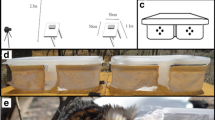Abstract
The role of sun compass orientation in spatial memory of Clark’s nutcrackers, Nucifraga columbiana, and pinyon jays, Gymnorhinus cyanocephalus, was studied in a series of cache recovery experiments. Birds were tested in an octagonal outdoor aviary with sand-filled cups inserted in the floor. For caching, only 12 such cups in a 90° sector were available, while for recovery 4–7 days later all 48 cups in the entire aviary were open. In control tests, the birds concentrated their search activity in the sector where they had cached. When their internal clock was shifted 6 h between caching and recovery, pinyon jays shifted their search activity to the 90° adjacent sector, as predicted if the sun compass was used. Clark’s nutcrackers did not respond to the first clock-shift; however, they, too, shifted their search activity after a second clock-shift back to normal. This suggests that the sun compass is a component of spatial memory in both species. Clark’s nutcrackers, however, seem to rely on their sun compass to a lesser degree than pinyon jays or the previously studied scrub jays. A comparison of the findings indicates that the role of the sun in spatial memory might reflect differences in habitat and ecology of the three corvid species.
Similar content being viewed by others
Author information
Authors and Affiliations
Additional information
Received: 18 February 1999 / Accepted after revision: 17 September 1999
Rights and permissions
About this article
Cite this article
Wiltschko, W., Balda, R., Jahnel, M. et al. Sun compass orientation in seed-caching corvids: its role in spatial memory. Anim Cogn 2, 215–221 (1999). https://doi.org/10.1007/s100710050042
Issue Date:
DOI: https://doi.org/10.1007/s100710050042




